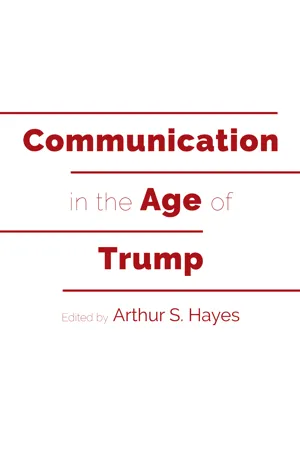
- 354 pages
- English
- PDF
- Available on iOS & Android
Communication in the Age of Trump
About this book
Franklin Delano Roosevelt used radio fireside chats to connect with millions of ordinary Americans. The highly articulate and telegenic John F. Kennedy was dubbed the first TV president. Ronald Reagan, the so-called Great Communicator, had a conversational way of speaking to the common man. Bill Clinton left his mark on media industries by championing and signing the landmark Telecommunications Act of 1996 into law. Barack Obama was the first social media presidential campaigner and president. And now there is President Donald J. Trump.
Because so much of what has made Donald Trump's candidacy and presidency unconventional has been about communication—how he has used Twitter to convey his political messages and how the news media and voters have interpreted and responded to his public words and persona—21 communication and media scholars examine the Trump phenomenon in Communication in the Age of Trump. This collection of essays and studies, suitable for communication and political science students and scholars, covers the 2016 presidential campaign and the first year of the Trump presidency.
Frequently asked questions
- Essential is ideal for learners and professionals who enjoy exploring a wide range of subjects. Access the Essential Library with 800,000+ trusted titles and best-sellers across business, personal growth, and the humanities. Includes unlimited reading time and Standard Read Aloud voice.
- Complete: Perfect for advanced learners and researchers needing full, unrestricted access. Unlock 1.4M+ books across hundreds of subjects, including academic and specialized titles. The Complete Plan also includes advanced features like Premium Read Aloud and Research Assistant.
Please note we cannot support devices running on iOS 13 and Android 7 or earlier. Learn more about using the app.
Information
Table of contents
- Cover
- Contents
- List of Figures
- List of Tables
- Introduction (Arthur S. Hayes)
- Part I: Blurred Lines: When Reality TV Becomes Political Reality
- Part II: Campaign and Presidential Rhetoric
- Part III: Assessing News Media Performance
- Part IV: Why Twitter and Facebook May Never Be the Same
- Contributors
- Index